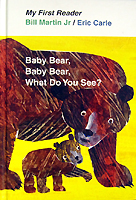|
|
|
|
|
|
|

| 최근 이 책을 구매하신 다른 회원의 책장 |
|
 |
|
|
|
[ 책 소개 ]
Eric Carle의 세계적인 베스트셀러인 Bear시리즈입니다.
이 책에서는 Brown Bear, Polar Bear, Panda Bear에 이어 다른 책에는 등장하지 않는 빨간 여우, 날다람쥐, 야생 염소, 파란 학, 프레이리독, 스컹크, 뮬사슴, 방울뱀, 올빼미, 엄마곰 등이 차례로 등장하며, 반복되는 운율을 따라 책을 읽다 보면 자신도 모르게 쉽게 영어를 익힐 수 있습니다. 각 페이지 마다 각기 다른 색깔의 동물들이 나오기 때문에 동물 이름과 색깔을 영어로 말하는 법도 배울 수 있습니다.
에릭칼의 My First Reader 시리즈는 세계적인 베스트셀러를 어린 아이들에게 익숙한 beginning reader 형식으로 만들었습니다. 책 말미에는 독후 활동을 통해 동물 이름, 동물들의 움직임, 서식지, 동물 특징 등 책의 내용을 복습할 수 있는 Reading Activity 문제들이 포함되어 있습니다.
[ 관련 동영상 보기 ]
 ▶
[ 서지 정보 ]
Paperback: 40 pages
ISBN-10: 0805092919
ISBN-13: 978-0805092912
책 크기 : 22.8 cm x 15.2 cm
[ 영문 서평 ]
Book Description
The publication of Panda Bear, Panda Bear, What Do You See? and Baby Bear, Baby Bear, What Do You See? completes the bear book beginning reader series. Now, children can read all four books on their own in this special format.
With the important pre-reading concepts of rhyme, rhythm, and repetition, these picture books have long been used as beginning readers. The new 6 x 9 trim and classic beginning reader layout create a more “grown up” version to read by themselves.
Complete with a letter from master educator Laura Robb, and with fun reading activities added, these new versions of Panda Bear, Panda Bear, What Do You See? and Baby Bear, Baby Bear, What Do You See? are certain to appeal to a new age group and find an even wider audience.
From Booklist
Forty years ago, Martin and a newcomer named Eric Carle launched a cottage industry with their now-beloved classic, Brown Bear, Brown Bear, What Do You See? (1967). After narrowing the original book's broad purview in two sequels, Polar Bear, Polar Bear, What Do You Hear? (1991), about zoo animals, and Panda Bear, Panda Bear, What Do You See? (2003), about endangered animals, this third sequel continues the thematic approach with an all-American assemblage and attention paid to the continent's many regions (a mountain goat, a rattlesnake, and a blue heron are among the creatures depicted). Martin's rhythmic text cleaves to the familiar pattern and leads readers from one double-page animal portrait to another, all crisply set against white backgrounds. Adults may appreciate the educational prospects of the North American angle, but the appeal here for the youngest children - as with the book's predecessors - will be in examining the complex, collaged textures within Carle's simple forms and in gleefully anticipating the appearance of each critter in the sequence.
The Times Educational Supplement
The natural history is a source for smiles, the illustrations in collage and paint are little works of art
Junior Magazine
Carle's books all have an educational element -- they teach about animals, numbers, colours and nature -- but a big part of their appeal is that they are not didactic or laboured, but light and entertaining. There's warmth and humour there too
|
|
|
|
|
|
|
|
|